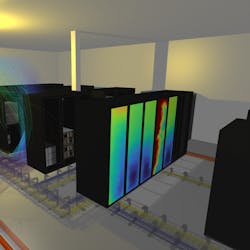Data Center Modernization: The Untapped Green Initiative
While much of the recent focus has been on building new, ultra-sustainable data centers, I’d like to turn the industry’s attention to another significant means of addressing our sector’s sustainability goals: modernizing legacy data centers.
Legacy data centers face difficulties deploying new, evolving IT in a fixed infrastructure. This becomes especially complex with high-density equipment, particularly from a thermal perspective. Not knowing the true capacity of a data center can mean that operations teams can build too much redundancy into their systems to ensure IT doesn’t overheat. Many operators are reluctant to maximize capacity utilization because of the potential risk involved. Stranded capacity leaves both money and sustainability efforts on the table.
There are two primary difficulties in measuring progress on sustainability initiatives for legacy data centers. First, one cannot improve data center operating performance without measuring it. This is easier said than done because of the second issue: sustainability metrics, particularly carbon emissions, power consumption, and water use, are interconnected. Improving one of these metrics could negatively impact another.
This interconnection is why it’s essential to have a tool that can properly measure data center performance holistically. Cadence’s data center digital twin technology creates a physics-based simulation of the entire data center that can help operators study metrics essential to sustainability goals, continuously generate reports, and ultimately, streamline the data center modernization process.
A recent example of this is the work we did with one of America's leading healthcare providers that sought to modernize its legacy data centers. This healthcare enterprise needed to minimize stranded capacity without compromising resilience. Specifically, it required a predictive tool to help it overcome power, cooling, and space challenges brought on by the extreme demands of high-density systems. Given the significant and sensitive nature of its business, the healthcare enterprise needed a fail-safe way to accomplish these goals.
Every medium-sized IT deployment now undergoes an examination using the data center digital twin’s physics-based simulation before deployment to assess its impact on power deployed, cooling required, airflow, percentage of IT within thermal limits, and the percentage of IT at risk. This methodology helps the healthcare enterprise understand both the impact of the deployment on the surrounding area and installed IT and on the data center overall. Deployments are assessed with the data center in normal operation and during various power and cooling failure scenarios to stress test the deployments in worst-case conditions.
This examination process empowers the enterprise to continually reduce the inefficiencies at the heart of high-density deployments and better understand how these deployments will work alongside lower-density IT equipment, while still maximizing uptime.
Data center digital twin technology gives legacy data centers a scientific foundation to build upon when executing data center modernization strategies without relying on costly testing or inaccurate assumptions. Furthermore, legacy owners can extend the lifetime of their existing data center portfolio rather than investing heavily in new data center space or moving to colocation or cloud providers.
Mark Fenton is Product Marketing Manager at Cadence Design Systems (formerly Future Facilities). Contact them to learn more.



